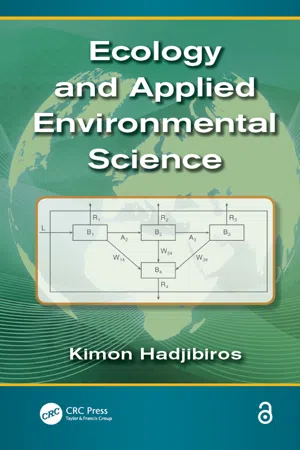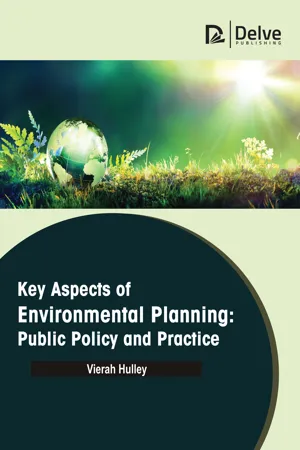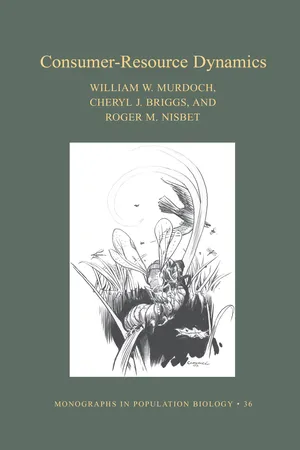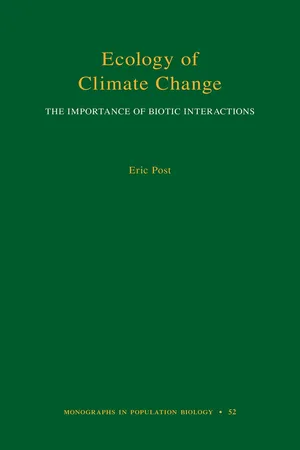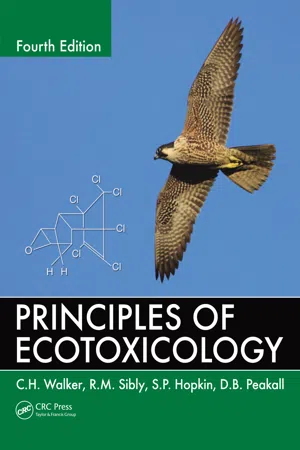Biological Sciences
Population Dynamics
Population dynamics refers to the study of how populations of organisms change over time. It involves examining factors such as birth rates, death rates, immigration, and emigration to understand population growth or decline. This field also explores the interactions between different species within a community and the impact of environmental factors on population size and distribution.
Written by Perlego with AI-assistance
Related key terms
1 of 5
9 Key excerpts on "Population Dynamics"
- eBook - PDF
- Kimon Hadjibiros(Author)
- 2013(Publication Date)
- CRC Press(Publisher)
Its purpose is to examine the way in which population sizes change through time, along with the analysis of the causes of these variations. This study is of great practical importance given that humans are interested in the prediction, or even control, of the size of various human or other animal, plant or micro-organism populations. Population Dynamics is a mathematical branch of ecology that uses vari-ous simple or complex models. Mathematical analysis of human popula-tions is similar to the analysis of other animal populations with overlapping generations. In Population Dynamics, deterministic or stochastic models, differential equations, or other mathematical tools such as matrices are used. In simpler models, a basic assumption stating that all population individuals are identical is followed; therefore the population state can be described with only one variable—its size, N . Population percentage Population percentage Population percentage Age 80 + 75 – 79 70 – 74 65 – 69 60 – 64 55 – 59 50 – 54 45 – 49 40 – 44 35 – 39 30 – 34 25 – 29 20 – 24 15 – 19 10 – 14 5 – 9 0 – 4 Figure 3.4 Pyramids of three human populations, with increase rates 2.1%, 0.6%, and 0.0% per year. (From Hadjibiros 2007. Ecology. Ecosystems and Environmental Protection, 3rd edition. Symmetria, Athens. With permission.) Organisation at Population Level 19 © 2010 Taylor & Francis Group, LLC A central issue for ecology is the search for the causes of ecosystem sta-bility, which are considered to be connected with the interactions between populations. The explanation of ecosystem stability represents a main theo-retical and practical challenge for Population Dynamics. The existence of stability, a precondition for persistence, is an important criterion for evalu-ating models used to describe ecological phenomena. However, the high complexity of ecosystems does not allow, at least for the time being, the formulation of a stability theory. - eBook - PDF
Ecology
Principles and Applications
- J. L. Chapman, M. J. Reiss(Authors)
- 1998(Publication Date)
- Cambridge University Press(Publisher)
These changes are what make populations dynamic. Populations gain individuals when young are born in the area (birth, B) or new members join the group from other populations (immigration, I). Immigration is most common in mobile species such as mammals, birds, fish, insects and so on. In plant species immigrants are usually seeds or spores. Populations lose organisms when they die (death, D), or when they leave an area to join another population (emigration, E). If the gains due to the birth and immigration of individuals are equal to the losses due to death and emigration then the symbols representing these gains and losses can be used in the following equation: B+1=D+E This shows that the population is stable, neither increasing nor decreasing in number over a period of time. It is in equilibrium. If the population gains are 23 4 Population Dynamics B < c 6 D gains population losses X / \ Figure 4.1 The changes which take place in the numbers of a population (the Population Dynamics) can be quan- tified using just four pieces of information. Gains in pop- ulation numbers are due to births (B) and immigration (7): losses are due to deaths (D) and emigration (E). greater than losses, that is if B+I>D+E then the population will increase in size, and if the losses are greater than the gains, that is if B + KD + E then the population will decrease in size and may cease to exist. The rate at which mature adults are replaced in a stable population which is in equilibrium will depend on the life span of the organisms. As we saw for bracken in Section 3.2.2. if an individual is capable of living several hundred years, then the death rate of adults will be low. It follows from this that the rate of successful replacement of adults will also be low. The birth rate may still be large, but in the case of a long- lived organism nearly all the young will die before they are mature. - Vierah Hulley(Author)
- 2023(Publication Date)
- Delve Publishing(Publisher)
Population Dynamics AND ENVIRONMENTAL PLANNING CHAPTER5 CONTENTS 5.1. Population Dynamics Introduction.................................................... 92 5.2. Implications of Specific Population Factors for Environmental Planning ............................................................ 94 5.3. Population Size ................................................................................. 95 5.4. World Population Distribution .......................................................... 95 5.5. Mediating Factors: Technology, Policy, and Cultural Factors .............. 97 5.6. Population-Environment Theories...................................................... 98 5.7. Environmental Planning Implications on Population Dynamics....... 104 Key Aspects of Environmental Planning: Public Policy and Practice 92 5.1. Population Dynamics INTRODUCTION The world’s population has grown by a total of 2 billion people since the beginning of the century, bringing the total to 7 billion. According to the most recent forecasts, the world population would grow by at least 2 billion people by the year 2050. The diversity of the world’s population is at an all-time high, not just across and within countries and regions, but also inside individual nations. This pattern may be spotted all over the world. This variation in overall population size can be attributable to a variety of variables, including varying proportions of young and elderly individuals, fluctuating rates of conception, illness, and death, population growth, urbanization, and migration both within the nation and from other countries (Figure 5.1) (Tonn et al., 2000). Figure 5.1. Population Dynamics. Source: https://image.slidesharecdn.com/populationdynam- ics-121031071441-phpapp02/85/population-dynamics-1–320. jpg?cb=1351667718. Furthermore, there is a substantial disparity across nations and localities in terms of economic progress and educational achievement.- eBook - PDF
Avian Biology
Volume I
- Donald S. Farner, James R. King, Donald S. Farner, James R. King(Authors)
- 2013(Publication Date)
- Academic Press(Publisher)
Chapter 9 Population Dynamics Lars von Haartman I. Definition 392 II. Bird Numbers 392 A. Total Numbers 392 B. Bird Numbers in Forests 393 C. Bird Numbers in Lakes 397 D ' Factors, Other than Food, Influencing Bird Density 399 E. Conclusions 405 F. Numbers Outside the Breeding Season 406 III. Population Fluctuations 407 A. General 407 B. Selected Case Histories 407 C. Stability versus Instability in Bird Populations 415 D . Stability and Density Dependence 416 IV. Clutch Size 419 A. Adjusted Reproduction 419 B. D o Nidicolous Birds Rear as Many Young as They Can Nourish? 420 C. Clutch Size in Species Not Feeding their Young 425 D . Basic Similarities in Clutch Size in Nidicolous and Nidifugous Birds 426 E. Second Broods 427 F. Conclusions 429 V. Territory 430 A. The Influence of Territory on Habitat Selection 430 B. Population Reserve 433 C. Functions of Territory 435 D . Territory and Food 436 E. Delayed Sexual Maturity 438 VI. Mortality 439 A. Losses in the Nest 439 B. Mortality in Adult Birds. Methods 441 391 392 LARS VON HAARTMAN C. Survival in Nature as Compared with Potential Survival D . Balance between Natality and Mortality E. Adult Mortality at Different Times of the Year F. Juvenile Mortality G. Density Dependent Mortality 443 444 445 445 446 449 References I. Definition Population Dynamics is the attempt to explain animal numbers in space (locally or, more or less, globally) and in time (such as seasonal or annual fluctuations). II. Bird Numbers A. TOTAL NUMBERS Total numbers of birds are sometimes measured in billions, but this expression means different things in different languages and even in different dialects of the same language (e.g., in England a billion is a million millions; in North America, a thousand millions) and is there-fore unsuitable. Fisher (1951) estimates the total number of birds on earth to be on the order of 100,000,000,000. - eBook - PDF
- William W. Murdoch, Cheryl J. Briggs, Roger M. Nisbet(Authors)
- 2013(Publication Date)
- Princeton University Press(Publisher)
C H A P T E R T W O Population Dynamics: Observations and Basic Concepts This chapter has two parts. The first discusses the various types of Population Dynamics observed in nature. The second looks at basic concepts that relate these observations to mathematical theory. A brief appendix introduces local stability analysis, illustrated by the logistic model. TYPES OF Population Dynamics: PHENOMENA TO BE EXPLAINED In this section we present a range of observed dynamics seen in popula-tions. By “dynamics” we mainly mean temporal changes in density or abundance. Average density of a population, and the relative densities of different populations, are of course also of interest. For example, we care greatly about average density in pest control and in populations we harvest, and we would like to be able to explain why some species are rare, others common, and why the general pattern of relative abundance of different species in an area is often maintained over ecologically long periods. Interestingly, particular types of dynamics do not appear to be restricted to any particular group of organisms or environments. Cyclic populations, for example, occur in terrestrial, freshwater, and marine habitats. They are found in birds, mammals, insects, fish, marine crabs, etc. (Kendall et al. 1998). Only in plants do cycles appear to be rare, per-haps because they often compete with other plant species for non-living resources. P O P U L AT I O N D Y N A M I C S 7 Biological Control of California Red Scale by Aphytis melinus We first introduce a particular system, California red scale and its “nat-ural enemies,” since we use it to illustrate various phenomena we wish to explain. This system also motivated many of the models discussed later in the book, so we briefly summarize its natural history here. California red scale, a plant-sucking insect (Homoptera), was acci-dentally introduced to southern California, probably from China via Australia, more than 100 years ago. - eBook - PDF
Ecology of Climate Change
The Importance of Biotic Interactions
- Eric Post(Author)
- 2013(Publication Date)
- Princeton University Press(Publisher)
Hence, we may discover that the magnitude of population response to climate change matters at least as much as, or perhaps even more than, the direction of population response to climate change. ESTABLISHING THE FRAMEWORK FOR ADDRESSING POPULATION RESPONSE TO CLIMATE CHANGE Understanding the contribution of abiotic variation to Population Dynamics will prove central to our efforts to predict the persistence of populations in a changing climate. Understanding persistence, in turn, is of fundamental impor- tance to efforts to predict the fate of species in a changing climate. And under- standing the fate of species in a changing climate is of essential importance to understanding the implications of climate change for species interactions and community dynamics and persistence. This chapter establishes a foundation for what unfolds in the rest of the book as we examine, in subsequent chapters, community dynamics and stability, biodiversity, and ecosystem function. Population Dynamics, or the variation in abundance of a population through time, can be decomposed into two components, density-dependent and density- independent processes. Density-dependent processes are those involving com- petitive interactions among members of the same species within the same population that influence survival and reproduction. Density-independent pro- cesses are those that do not involve interactions with other members of the same species in the same population but rather owe to external factors such as environmental variation. It is this latter set of processes that has relevance to climate change, though density dependence certainly has a role to play in the response of populations to climate change. Density dependence may, for instance, operate in tension with climatic influences on dynamics, in which case density dependence will tend to limit abundance to densities below which climatic effects on changes in population size are minimal. Alternatively, - eBook - PDF
Survey of Biological Progress
Volume 1
- George S. Avery, E. C. Auchter, G. W. Beadle, George S. Avery, E. C. Auchter, G. W. Beadle(Authors)
- 2013(Publication Date)
- Academic Press(Publisher)
It is one of these more abstract aspects, namely biodemography or the ecology of homogeneous populations, and its extension to very simple cases of interaction of two species, with which this contribution is concerned. To present a review of all significant advances in ecology in a single article, produced in collaboration by a finite number of writers, is obviously impossible. It has therefore seemed best to plan a series of articles to appear over a number of years that will finally cover the significant modern advances in those sciences that consider organisms in relation to their environments and to one another. When the whole field has thus been surveyed the present article will be sufficiently out of date to justify return-ing to its subject matter. This subject matter has been chosen for several reasons. Firstly, it occupies a central place in modern ecological thought, and has a considerable bearing on other aspects of biology, notably evolution theory. Secondly, though demographic concepts have primarily been evolved in the study of animal ecology, there is no reason why they should not be applicable to plant ecology and might indeed play a part in the current rejuvenation of that science, which has in the past shown an arthritic ECOLOGICAL STUDIES ON POPULATIONS 327 tendency. Thirdly, the kind of matter that is presented below is the only part of biology other than genetics to have developed an autonomous quantitative theory independent of the physico-chemical sciences. Fourthly, though the heroic period in the development of that theory reached its peak rather more than a decade before the publication of most of the material to be considered, the years since 1934 have shown an interesting and significant cooperation involving the field naturalist, taxonomist, experi-mentalist and mathematician, which has of course also affected genetics and evolutionary studies. - eBook - PDF
- C.H. Walker, R.M. Sibly, R.M. Sibly, D.B. Peakall(Authors)
- 2016(Publication Date)
- CRC Press(Publisher)
The evolution of resistance is considered in Chapter 13. In this chapter we introduce the ecological theory needed to interpret and understand the processes that may operate to produce curves such as those in Figure 12.1. Before we can describe populations, we need a method that determines which organ-isms are in the population and which are not. Often geographic boundaries are used. The choice of these boundaries has two very important consequences. In the first place, if the area chosen to define a population is too small, there will be extensive migration in and out of the population. This produces problems in population analysis because the migra-tion rates have to be estimated, and this is far from easy. Second, population analyses are specific to the environment in which the population occurs. Change the environment, and the population parameters and the processes that determine them may all change. In these two ways, the choice of geographic boundaries is likely to have large effects on the results of population analyses. The simplest description of a population is in terms of its abundance. This is discussed in the next section. 208 Principles of Ecotoxicology, Fourth Edition 12.1 Population Abundance Population abundance measures the size of a population, generally as the number or den-sity of individuals within it. Abundance is the most widely used descriptor of populations and the easiest to understand, and the effects of pollutants on populations are most easily understood in terms of their effects on abundance, as in Figure 12.1. Most studies of the effects of pollution plot abundance against time; for examples, see Figures 12.10, 12.14, 12.17, 12.22, and 12.24. Note that some of these also show the duration of pollution events that may have been responsible for population changes. What happens to abundance is of central concern in assessing the effects of pollution, because stressors and disturbances generally depress population size. - eBook - PDF
- Narendra S. Goel, Nira Richter-Dyn(Authors)
- 2013(Publication Date)
- Academic Press(Publisher)
6 Dynamics of a Population of Interacting Species In Chapter 4 we discussed the growth and extinction of a single-species population in the presence of some random elements affecting both the basic mechanisms of population growth and the factors determining it. In most natural systems, every species interacts with a number of other species, either through prey-predator interactions (by eating or by being eaten) or through competition for the same food. In this chapter we study two aspects of a population of interacting species. One aspect is the mechanism behind the changes in the species diversity (which can be crudely defined as the number of species per unit area) in a particular region. The changes involve the processes of extinction r of some of the species and immigration of other species from nearby regions. A detailed insight into these two processes and how they affect the species diversity can be provided by the detailed analysis of species diversity on a set t We have neglected the emigration of the species. As can be seen in the discussion of Section 6.1, this can be easily incorporated into the formalism. 120 Species Diversity on Islands 6.1 of islands in the same geographic region for which a few experimental data are available. Such an analysis was carried out by MacArthur and Wilson (1963), and in the next section we present their linear model in the language of Chapter 2, introduce a nonlinear model also, and modify some of the results. The other aspect, discussed in Section 6.2, is the dynamics of an individual species that interacts with many other species. 6.1 Species Diversity on Islands In a set of small islands in the same region, the increase in the number of species (diversity) on a particular island takes place due to immigration of new species from a nearby big island (or continent) which will be called the pool of species.
Index pages curate the most relevant extracts from our library of academic textbooks. They’ve been created using an in-house natural language model (NLM), each adding context and meaning to key research topics.
